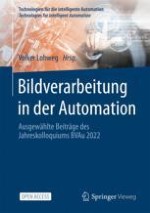1 Introduction
1.1 State of the Art
1.2 Related Work
1.3 Research Question
2 Approach
2.1 Concept
2.2 Detailed description
(a) compared to … | (b) | (c) |
|---|---|---|
Without masking | 48% | 47% |
With masking | 56% | 30% |

Open Access 2023 | OriginalPaper | Buchkapitel
verfasst von : Markus Brüning, Paul Wunderlich, Helene Dörksen
Erschienen in: Bildverarbeitung in der Automation
Verlag: Springer Berlin Heidelberg
Aktivieren Sie unsere intelligente Suche, um passende Fachinhalte oder Patente zu finden.
Wählen Sie Textabschnitte aus um mit Künstlicher Intelligenz passenden Patente zu finden. powered by
Markieren Sie Textabschnitte, um KI-gestützt weitere passende Inhalte zu finden. powered by
(a) compared to … | (b) | (c) |
|---|---|---|
Without masking | 48% | 47% |
With masking | 56% | 30% |